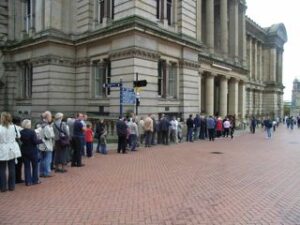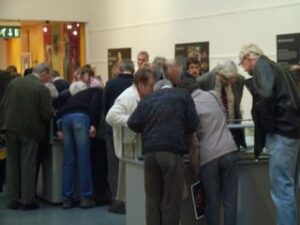The hoard is an extraordinary find and deserves most of the excitement that has surrounded it. However there is much more going on than straightforward archaeological interest in the objects and their manufacture.
Arriving at Birmingham Museum & Art Gallery, soon after the museum opened on saturday morning met a long queue that stretched down the main stairs and into Chamberlain Square. The previous day, when the display had opened, the museum had around 2000 visitors coming to see the finds, and is now letting small groups see the objects for controlled amounts of time.
These are small things, mostly sword fittings, so people have to crowd around the cases and peer at the delicate craftsmanship (See photos by my friend David Rowan).
However, now that the hoard has been discovered, and once the initial excitement dies away, further questions will arise about who it belongs to. Possession is an important part of the process by which archaeology and history become converted into heritage and put to work politically.
An inquest on 24th September found the hoard to be “treasure trove” and it therefore belongs to the crown. The finder and landowner will be rewarded to the value of the find. Such a discovery would once have been moved directly to the British Museum in London, as the nation’s main repository for archaeology. However questions have increasingly been raised about whether things that come from other parts of the British isles are necessarily best displayed in London (such as the Lewis Chessmen).
The last decade has seen the BM engaged in a series of partnerships with regional museums, such as Birmingham, and this seems to have tempered some of the acquisitiveness of the London curators. The decision to display the find in Birmingham before it has been valued in London is unprecedented and recognises the importance of the regional interest in the find, as well as the work that has been done at Birmingham Museum. However although the finds liason officer to whom the find was reported is based at Birmingham, the hoard was actually discovered in Staffordshire.
It seems that the Staffordshire County Council and the Stoke-on-trent City Council are interested in the find and are keen to claim it for themselves. The leader of Staffordshire County Council has declared “This is our heritage and we need to do it justice”.
Meanwhile, the leader of Stoke on Trent City Council has declared “This… will entice people from around the world to visit Staffordshire and the potential for this find to stimulate learning and regeneration is simply incredible.”
The leader of Birmingham Council Mike Whitby is on Youtube suggesting that the horde displays “the level of civilization within the midlands” and has suggested that it will teach us about “our heritage” but has urged for unity “so that we can keep the majority, if not all of this collection here in the midlands, its rightful home”.
Although it is the declared aim of all three councils to attempt to acquire the collection jointly, how this will work and who will display which objects will only be resolved by long and complex negotiations. Council funded museum services are under major financial pressure across the country, and curatorial posts have been cut under the watch of some of the same council leaders who are now so interested in acquiring the hoard.
Finding a pot of gold at the end of the rainbow may only be the beginning of this story, as people will now have to decide who it belongs to and what should happen to it. Given the rise of groups such as the English Defence League, who have recently been protesting in Birmingham, it probably won’t be long before people start connecting the Anglo-Saxon origins of the objects and their important as heritage for the ‘English’ as an exclusive ethnic group.





According to the Daily Mail, "the early Anglo-Saxons founded England as we know it."
Read more: http://www.dailymail.co.uk/sciencetech/article-1215723/Staffordshire-hoard-Amateur-treasure-hunter-finds-Britains-biggest-haul-Anglo-Saxon-gold.html#ixzz0SJEdJEHC